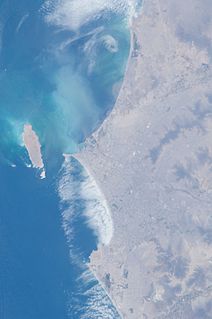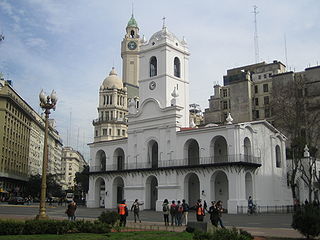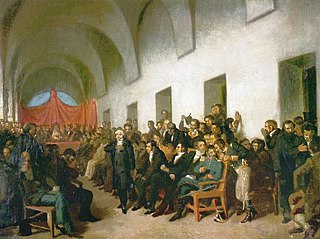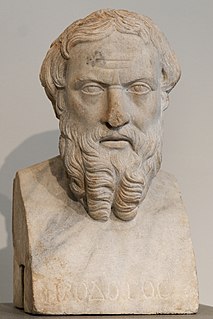
Francisco Pizarro González was a Spanish conquistador who led the Spanish conquest of the Inca Empire. He captured and killed Incan emperor Atahualpa, and claimed the lands for Spain.

Lima is the capital and the largest city of Peru. It is located in the valleys of the Chillón, Rímac and Lurín rivers, in the central coastal part of the country, overlooking the Pacific Ocean. Together with the seaport of Callao, it forms a contiguous urban area known as the Lima Metropolitan Area. With a population of more than 9 million, Lima is the most populous metropolitan area of Peru and the third-largest city in the Americas, behind São Paulo and Mexico City.

The Viceroyalty of Peru was a Spanish imperial provincial administrative district, created in 1542, that originally contained modern-day Peru and most of Spanish-ruled South America, governed from the capital of Lima. The Viceroyalty of Peru was one of the two Spanish Viceroyalties in the Americas from the sixteenth to the eighteenth centuries.

Trujillo is a municipality located in Extremadura, an autonomous community of Spain in the Province of Cáceres. It had 9086 inhabitants. Originally settled on a granite knoll which was readily fortified, the town now extends to the South East of its original site. Trujillo is both a centre for tourism, with over 25 hotels, and a regional market town.

The Basilica Cathedral of Lima, otherwise Lima Cathedral, is a Roman Catholic cathedral located in the Plaza Mayor of downtown Lima, Peru. Construction began in 1535, and the building has undergone many reconstructions and transformations since. It retains its colonial structure and facade. It is dedicated to St John, Apostle and Evangelist.

Lima is a district of Lima Province in Peru. It is, however, not the Central business district of Lima, the country's capital city: this is San Isidro District.

The Lima metropolitan area, is an area formed by the conurbation of the Peruvian city-provinces of Lima and Callao. It is the largest of the metropolitan areas of Peru, the seventh largest in the Americas, the fourth largest in Latin America, and among the thirty largest in the world. The conurbation process started to be evident in the 1980s. The metropolitan area is composed of six subregions. These are Lima Norte, Lima Sur, Lima Este, Residential Lima, Central Lima, and Callao. Its estimated 2018 population is 12 million according to INEI statistics.

Located principally in the city centre or Cercado de Lima and Rímac areas, the Historic Centre of Lima is among the most important tourist destinations in Peru.

The Buenos Aires Cabildo is the public building in Buenos Aires that was used as seat of the town council during the colonial era and the government house of the Viceroyalty of the Río de la Plata. Today the building is used as a museum.

Gabriel de Avilés Itúrbide y del Fierro, 2nd Marquis of Avilés was a Spanish military officer and colonial administrator in the Americas. He was governor of Chile, viceroy of Río de la Plata, and viceroy of Peru.

A cabildo or ayuntamiento was a Spanish colonial, and early post-colonial, administrative council which governed a municipality. Cabildos were sometimes appointed, sometimes elected; but they were considered to be representative of all land-owning heads of household (vecinos). The colonial cabildo was essentially the same as the one developed in medieval Castile.

The history of Lima, the capital of Peru, began with its foundation by Francisco Pizarro on January 18, 1535. The city was established on the valley of the Rímac River in an area populated by the Ichma polity. It became the capital of the Viceroyalty of Peru and site of a Real Audiencia in 1543. In the 17th century, the city prospered as the center of an extensive trade network despite damage from earthquakes and the threat of pirates. However, prosperity came to an end in the 18th century due to an economic downturn and the Bourbon Reforms.

Francisco de Aguirre was a Spanish conquistador who participated in the conquest of Peru, Bolivia, Chile and Argentina.

The Historic Centre of Trujillo is the main urban area and the most important center of development and unfolding in the Peruvian city of Trujillo located in La Libertad Region. The whole process of its original urban fabric is in elliptical shape surrounded by España Avenue that was built in the wake of the Wall of Trujillo. It houses the seat of city government and other important entities in the locality. In the center of this historic urban area is the Plaza de Armas of Trujillo that was the scene of the Spanish founded of the city in 1534 and the proclamation of the independence of Trujillo on December 29, 1820.

The Municipality of Trujillo is the Peruvian public institution of government for Trujillo Province, Peru. It is located in the city of Trujillo and is responsible for the supply and management of the province and its districts. This includes rural and urban towns and the provision of local services within its jurisdiction. It is a politically autonomous legal entity and as such it deals with economic and administrative matters.































